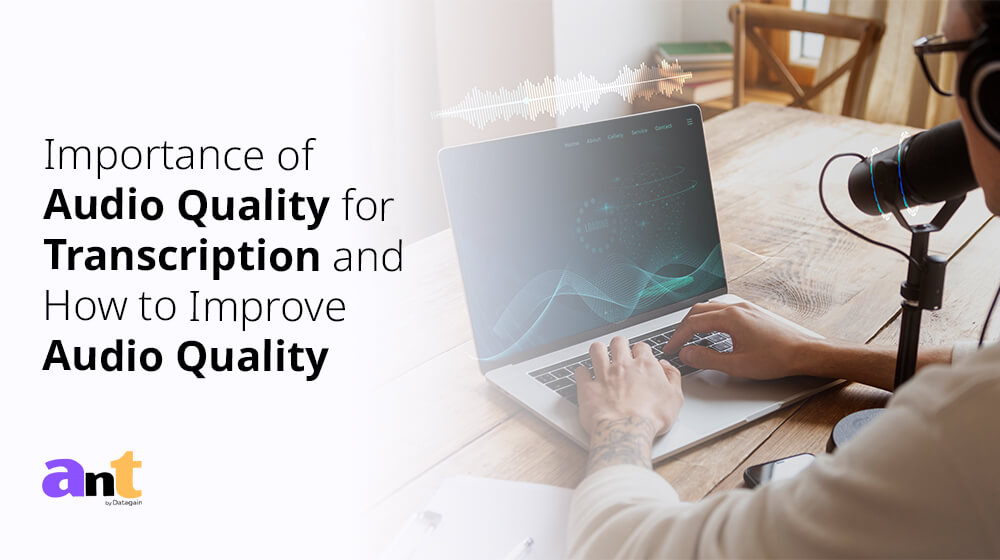Transcription serves as a fundamental component in the realm of qualitative research and analysis, playing a crucial role in transforming spoken words into written text for deeper examination and interpretation. In this blog, we delve into the significance of transcription and its indispensable role in qualitative research and analysis.
1. Capturing Rich Data
The role of transcription in qualitative research and analysis is paramount for capturing rich and detailed data from interviews, focus groups, or other spoken interactions. By transcribing these interactions verbatim, researchers can preserve the nuances, emotions, and intricacies of human communication, ensuring that no valuable information is lost during the analysis process.
2. Facilitating Thorough Analysis
Transcription facilitates thorough analysis by providing researchers with a written record of qualitative data that can be easily reviewed, annotated, and coded. This written form allows researchers to identify patterns, themes, and key insights more effectively, leading to a deeper understanding of the research topic.
3. Ensuring Accuracy and Reliability
The accuracy and reliability of qualitative research and analysis hinge on the quality of transcription. A precise and faithful transcription ensures that researchers are working with an accurate representation of the original spoken data, minimizing errors and inaccuracies in the analysis process.
4. Supporting Transparency and Reproducibility
Transcription plays a vital role in supporting transparency and reproducibility in qualitative research. By providing a clear and transparent record of the data collection process, including verbatim transcripts researchers enable others to replicate their findings and verify the accuracy of their analysis, thus enhancing the credibility of the research.
5. Enhancing Accessibility and Sharing
Transcription enhances the accessibility and sharing of qualitative data, allowing researchers to disseminate their findings more widely and reach a broader audience. Written transcripts can be shared with colleagues, stakeholders, or the broader research community, facilitating collaboration, feedback, and further analysis.
6. Facilitating In-depth Coding and Interpretation
In qualitative analysis, coding and interpretation are essential steps in uncovering underlying themes and patterns within the data. Transcription provides researchers with a detailed text that can be segmented, coded, and analyzed systematically, facilitating in-depth exploration and interpretation of the data.
7. Supporting Mixed-Methods Research
Transcription is particularly valuable in mixed-methods research, where qualitative and quantitative data are combined to provide a comprehensive understanding of a research topic. By transcribing qualitative data, researchers can integrate it seamlessly with quantitative data, allowing for a more holistic analysis and interpretation of research findings.
8. Adapting to Different Research Settings
The role of transcription in qualitative research and analysis is adaptable to various research settings and methodologies. Whether conducting interviews, focus groups, observations, or textual analysis, transcription serves as a versatile tool that can be tailored to meet the specific needs and requirements of different research projects.
9. Facilitating Reflexivity and Critical Engagement
Transcription encourages reflexivity and critical engagement among researchers by providing them with a written record of their interactions with participants. By reviewing and analyzing transcripts, researchers can reflect on their own biases, assumptions, and interpretations, fostering a more nuanced and self-aware approach to qualitative research.
10. Upholding Ethical Standards
Transcription upholds ethical standards in qualitative research by respecting the confidentiality and privacy of research participants. By transcribing data accurately and anonymizing sensitive information, researchers demonstrate their commitment to protecting the rights and well-being of those involved in the research process.
The Importance of Transcription in Qualitative Research
Transcription is a cornerstone of qualitative research, serving as the bridge between data collection and data analysis. By converting audio or video recordings into written text, researchers can more easily identify patterns, themes, and insights within the data. The role of transcription in qualitative research and analysis is crucial for ensuring that the nuances of participants’ spoken words are captured accurately, facilitating a thorough and detailed examination of the data.
Exploring Transcription Techniques
Understanding different transcription techniques and methodologies is essential for researchers aiming to harness the full potential of qualitative data. Techniques such as verbatim transcription, where every word and sound is transcribed exactly as spoken, and intelligent verbatim transcription, which omits non-essential fillers and false starts, offer varying levels of detail and focus. The choice of technique depends on the research objectives and the level of detail required for analysis.
Leveraging Technology for Transcription
Advancements in technology have revolutionized the transcription process, offering researchers innovative tools and software solutions to streamline transcription workflows. Automated transcription software can quickly convert speech to text, although human review is often necessary to ensure accuracy. The integration of machine learning and natural language processing into transcription tools has enhanced their reliability, making the transcription process more efficient and less time-consuming.
Navigating Challenges in Transcription
While transcription is a valuable tool in qualitative research, researchers often encounter challenges that can impact the quality and reliability of transcripts. Background noise, accents, and technical issues with recording devices can introduce errors or omissions in the transcripts. Additionally, the subjective nature of interpreting spoken language means that different transcribers might produce slightly different transcripts from the same audio. Addressing these challenges requires careful planning and quality control measures.
Transcription and Data Management
Effective data management is essential in qualitative research, and transcription serves as a key component of this process. Researchers must organize, store, and manage transcribed data systematically, ensuring that it is easily accessible for analysis. This includes implementing file naming conventions, data security measures, and version control strategies to maintain data integrity and facilitate collaboration among research team members.
Transcription in Multimodal Research
With the rise of multimodal research, which incorporates different data modalities such as text, audio, video, and images, transcription plays a vital role in analyzing diverse data sources. Researchers use transcription to convert audio and video data into written form, facilitating the integration and comparison of different types of data. This approach enriches the analysis and allows for a more comprehensive understanding of the research topic.
Addressing Cultural and Linguistic Nuances
Cultural and linguistic nuances pose unique challenges in transcription, particularly when working with diverse populations or conducting research in multilingual settings. Researchers must navigate these complexities with sensitivity and awareness, ensuring that transcripts accurately reflect the cultural and linguistic context of the participants. This may involve employing bilingual transcribers or using translation services to capture the full meaning of participants’ words.
Adapting to Varied Research Settings
Transcription techniques must adapt to the diverse research settings encountered by qualitative researchers. Whether conducting interviews in quiet offices, bustling coffee shops, or remote locations, transcriptionists must adjust their approach to capture clear and accurate audio recordings that can be transcribed effectively. This adaptability ensures that high-quality transcripts are produced regardless of the recording environment.
In conclusion, the role of transcription in qualitative research and analysis is indispensable, serving as a foundational tool for capturing, analyzing, and interpreting spoken data. By providing researchers with a written record of qualitative interactions, transcription facilitates thorough analysis, enhances transparency and reproducibility, and supports collaboration and sharing within the research community. As qualitative research continues to evolve, transcription remains a vital aspect of the research process, enabling researchers to uncover rich insights and advance knowledge in their respective fields. Contact Us!

















